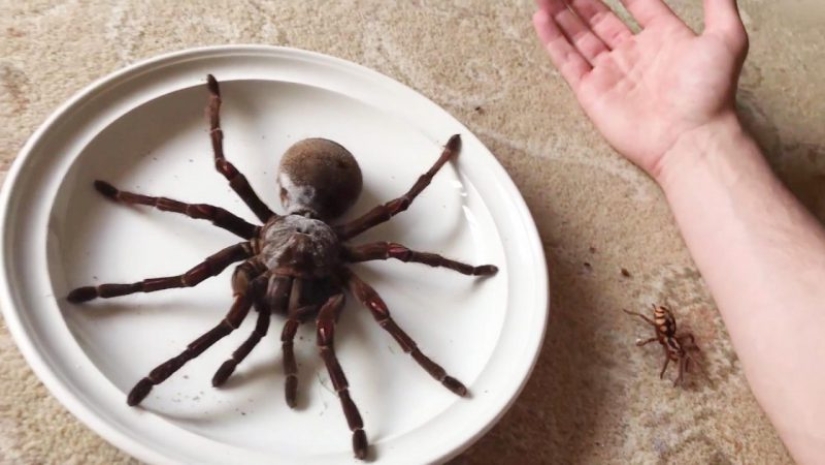Tarantula Goliath the largest spider on the planet
Categories: Animals | Nature | Science | World
By Pictolic https://pictolic.com/article/tarantula-goliath-the-largest-spider-on-the-planet.htmlSpiders are very difficult to attribute to everyone's favorites. These arthropods cause people to have fear, loathing or, at worst, cautious curiosity. True connoisseurs of spiders quite a bit and for them the best Pets are tarantulas.
With these creatures it's simple — the bigger, the cuter and therefore one of the most desirable "animals" in home terrariums is tarantula Goliath Theraphosa blond or blonde (Theraphosa blondi).

Experts say that Theraphosa blond Blondie — the largest of living on the Earth today spiders. The dimensions of this arthropod are really impressive — with outstretched legs, they can reach 28 inches. The body size in adult females is 9-10 cm

The biggest instance of tarantula Goliath, was discovered in 1965 in Venezuela expedition of the Pablo San Martin. Scientists found the female, with the length of legs 28 cm had a weight of 170 grams! To compete with this giant in size can only found in 2001 in Laos spider Heteropoda maxima with a leg span of 30 cm But the Asian fellow cannot compete with the record from South America body length and weight.

Heteropoda maxima
Areal Theraphosa Blonde is quite extensive. This giant spider can be found in tropical and Equatorial forests of Northern Brazil, Guyana, Suriname and Venezuela. The spiders of this species live in holes dug in the ground. To find out the dwelling of this arthropod can be on the thick layer of white web that covered the entrance.

Blonde Theraphosa diet consists of large insects, mice, lizards and even small snakes. Usually the spider hunts not far from the entrance to its hole, patiently waiting until the prey get close to the throw distance. Spider-Goliath and his way of life first described by French scientist and entomologist, Latreille in 1804.

Theraphosa blond blonde has quite a strong poison that can kill a mammal the size of a cat. For humans the bite of a spider of Goliath is not mortal danger, but is extremely unpleasant. A neurotoxin, is part of it, causing severe pain and cramping can last for several days.
In addition, the abdomen of the spider is covered with hairs that cause severe irritation in contact with skin and especially to the mucous. Scared Theraphosa blond blonde shakes them to the enemy legs, causing strong itching and suffocation. Places on the skin where you got the hairs, covered with burning blisters, as after contact with nettles.

Unfortunately, spider-Goliath every year are rarely found in nature. This is due to the fact that people are actively destroying the rainforest — wet forest is its habitat. In those countries where you can meet Theraphosa Blond, she is protected by law and its export is prohibited by law. In this regard, the spider-the record holder though is a welcome piece in each collection that is very rare in captivity.

Almost all instances of Goliath removed from their homeland by smuggling or derived from such exported illegally parents. By the way, breeding in captivity Theraphosa Blonde poses serious difficulties, since procreation requires a seasonal and even daily changes in temperature and humidity, and absolute peace.
Keywords: Brazil | Jungle | Smuggling | Nora | Spiders | Cobwebs | Arthropods | Venom
Post News ArticleRecent articles

Jacques-Henri Lartigue (1894-1986) is perhaps the most famous "amateur" in the history of photography. The art world discovered his ...

It turns out that an active lifestyle is useful not only for the body but for the brain. Exercise strengthens muscles and spirit, ...
Related articles

Franz Stangl was arrested on a grand scale. Several police cars and armored vehicles with machine guns, raising dust, surrounded a ...

The world community was shocked when in 2007 a dirty naked woman was found in the Cambodian jungle, who did not speak, could not ...

In 1960, located in the East of the African continent Uganda gained independence from Britain. But getting rid of colonial rule did ...

Most major companies profanity is not encouraged. It is considered that the profanity — it is a sign of disrespect for ...